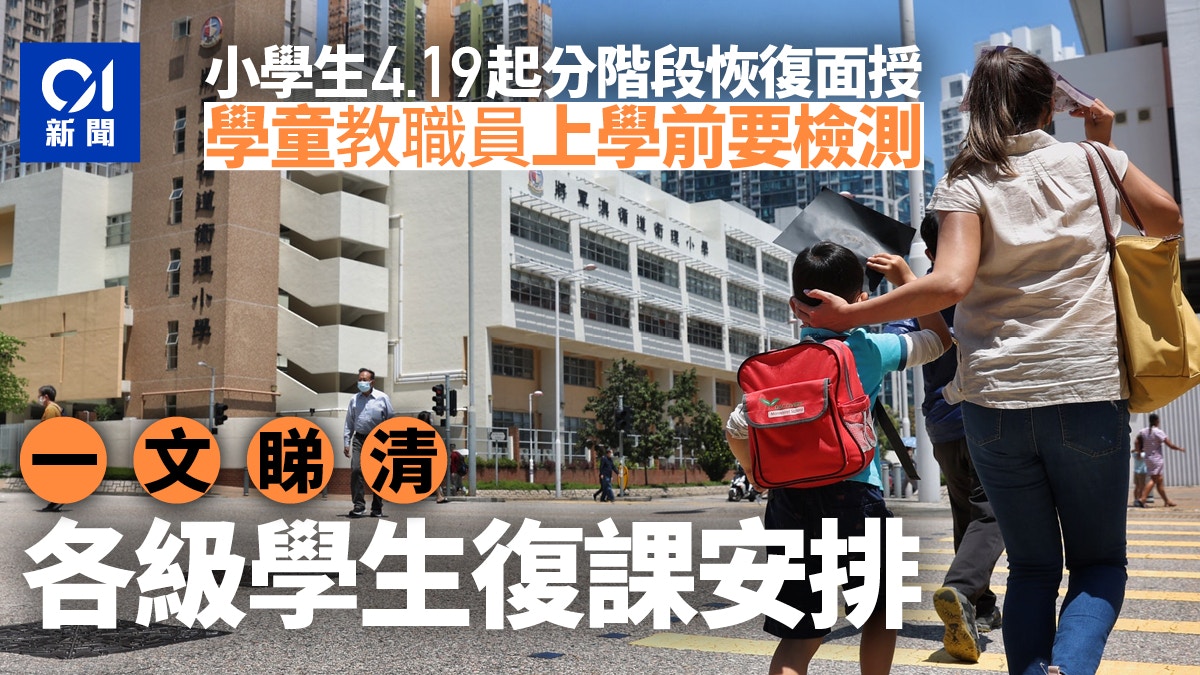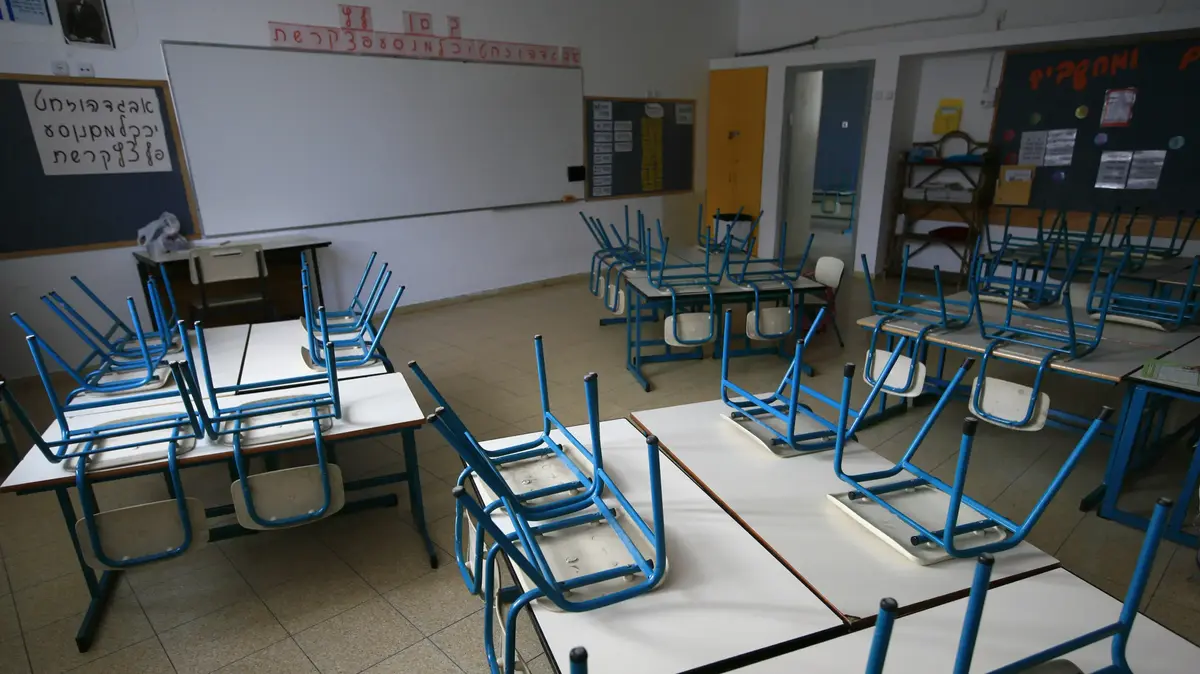The fifth wave of the epidemic has gradually eased. The government announced that all primary school students in Hong Kong will resume half-day face-to-face classes in phases starting from tomorrow (19th). Secondary schools and kindergartens will also resume classes on May 10 and 16 at the latest, and classes that have not resumed face-to-face teaching will continue to maintain online classes.
"Hong Kong 01" integrates relevant resumption information for students and parents.
▼On April 11, the Education Bureau announced that schools will resume classes from April 19▼
+2
Q1: When will face-to-face teaching resume for students at all levels?
Secondary schools to resume classes in stages from May 3
Secondary schools will resume classes in stages starting from May 3 after the completion of the core subjects of the Diploma of Secondary Education Examination (DSE). The whole school can resume classes immediately, and the whole school will resume half-day school on May 10 at the latest.
Elementary schools resume half-day face-to-face teaching on Tuesday
Primary schools will resume half-day classes in stages at the earliest on Tuesday (19th). Schools can decide whether they need to resume classes in batches, but the whole school will resume face-to-face teaching on May 3rd at the latest.
Kindergartens resume face-to-face teaching in three stages from May 3
In order to ensure that the school is fully prepared, kindergarten students will resume classes in three stages. 1/3 of the students (equivalent to Level 1) will return to the school on May 3 for face-to-face teaching, and the remaining 2/3 of the students will resume face-to-face teaching after May 10, May 16 The whole school will resume face-to-face teaching from the beginning of the day.
Tuition centers resume half-day face-to-face teaching from Tuesday
Special schools and schools offering non-local courses (including international schools) can refer to the above principles to resume classes, and can also make flexible arrangements according to the situation of each school; non-formal private schools such as tutoring agencies can arrange half-day classes as soon as April 19.
Q2: When will full-time face-to-face classes be resumed?
All primary schools and kindergartens are currently only allowed to have half-day physical classes. The Education Bureau said that it will pay attention to the development of the epidemic and continue to review the relevant arrangements.
Secondary schools also focus on half-day classes. If the overall or partial level reaches 90% vaccination rate, full-day face-to-face classes can be arranged.
Q3: Do students need to be vaccinated before returning to school?
The authorities said that they respected the right of students to receive education and would not force students to be vaccinated.
Although the school has implemented a "vaccine pass", it does not apply to students.
However, there are certain groups of students who need injections, including:
1. All schools, including special schools, dormitory students must complete one dose of the vaccine before May 15, and receive the second dose on time.
2. Secondary school students who need to return to school outside of face-to-face classes must complete two doses of the vaccine.
3. Kindergarten and primary school students who need to go back to school to be taken care of must have the first shot and the second shot on time before they can go back to school to receive care during non-school hours.
Q4: What is the difference between the students who have injections and those who do not have injections?
Non-academic activities are only available to students who have injections, not students who do not have injections.
Primary and secondary school students who have completed two stitches can participate in non-academic extracurricular activities, such as sports, music, etc., on the other half-day after completing the half-day face-to-face class.
However, due to the low self-care ability of kindergarten students, it is not suitable to carry out activities without masks for the time being. Unless there is no one to take care of them at home, they cannot stay in school for the other half day.
Q5: Are all staff and students tested before returning to school?
After the resumption of classes, staff and students will be required to take a final test before returning to school every day. A negative test can only go to school, and a positive test must immediately notify the school and the Center for Health Protection.
Students need to report the results within 24 hours on the "2019 Coronavirus Rapid Antigen Test Positive Results Reporting System".
Schools are also required to report on-campus test results to the government on a daily basis.
In late May, the government will review whether it is necessary to adjust the arrangement according to the development of the epidemic.
In addition, schools may conduct random inspections of cases and require students to re-examine.
If a student develops symptoms such as fever and cough after returning to school, the school will arrange for a re-examination.
The government will provide 10 million sets of rapid test kits for all schools in Hong Kong free of charge, which is expected to be enough for each school to use in the next month. It is estimated that more than 300,000 CSSA recipients, students receiving student allowances or students from families affected by the epidemic will receive them. Schools If the quick test kit is not enough, it can also be obtained from the Education Bureau.
▼The Tsuen Wan Chamber of Commerce School in Tsing Yi prepares for class resumption▼
+7
Q6: How can students take the quick test correctly?
The Hong Kong Paediatric Society, the Hong Kong Society of Children's Immunoallergy and Infectious Diseases, the Hong Kong Children's Hospital Simulation Training Centre, the Hong Kong Academy of Paediatric Nursing, and the Hong Kong Society of Paediatric Nurses have listed for parents the precautions for children undergoing rapid testing for COVID-19 (for details, please refer to read this URL):
To help children do a quick test, how long should the cotton swab be?
Parents and caregivers should refer to individual brand instruction manuals when using the COVID-19 rapid test.
For general nasal swab sampling, the depth of the nasal swab stick into the nasal cavity does not need to be too deep.
Children of different ages have different depths of swab sticks entering the nostrils.
Two to six years old: 1.5 to 2 cm
Six to twelve years old: 2 cm
Twelve to adults: 2 to 3 cm
Children gently blow their noses before sampling, and then parents and caregivers can use the "pencil grip" position to put the nasal swab stick into the children's nostrils.
Put the swab stick against the nasal wall and rotate it in the nasal cavity (please refer to the instruction manual of the individual brand for the number and time of rotation), then take out the nasal cavity swab stick, put it into the other nostril of the child, and repeat the above steps.
Properly mix the nasal swab stick with the test solvent when finished.
Place the test stick on a flat surface, drop the exact amount of mixed test solution into the sample well, and read the result within the specified time.
Will it cause nosebleeds and affect the health of children if they do a rapid nasal swab test?
Nasal swab sampling There are only a few microfilament blood vessels in the nasal cavity touched by the swab stick, so there is little chance of nosebleeds caused by the sampling procedure.
A slight nosebleed is not harmful to health.
If it is found that there is nosebleed after sampling, parents and caregivers should help the child press the sides of the nose, instruct the child to move forward slightly, and temporarily breathe through the mouth. Most of the nosebleeds will occur within 5 to 10 minutes. stop.
When is the right time to take a quick test for a child?
What lifestyle habits should I avoid before testing?
Parents and caregivers should take a nasal swab after the child wakes up.
Parents and caregivers should take nasal swabs in the morning. If the child fails to sit up in time, the sample can be taken before the child wakes up.
Before sampling, avoid rinsing your nose, drinking water, eating, brushing your teeth, and gargling your mouth, as these will reduce the number of viruses on the mucous membranes of the nasal wall, thereby reducing the sensitivity of the test.
Can parents use the oral test to do a quick test for their child?
The oral rapid test method has not yet been approved by the Centre for Health Protection of the Department of Health.
In addition, if children hold the test stick and make too much movement, it will easily lead to oral trauma. Therefore, it is not recommended to use this method to perform a rapid test for the new coronavirus for children.
▼April 12, Mong Kok pharmacies and shops will have the lowest price of 5 yuan per quick test▼
+6
Q7: Who does not need to take the quick test before returning to school?
Students who have been infected by the fifth wave of the epidemic are the same as those who have recovered. Students who are infected do not need to take a rapid test before going to school within 90 days after recovery.
Q8: What will the school do if a student forgets to take the quick test before returning to school?
If parents forget to take the quick test for their children before returning to school, and the school cannot test the students in the school, even if the students have returned to the school, they cannot go to the classroom.
The school will also call parents to see if they can go to the school for a quick test for their child, or take the child home directly.
Q9: Will a positive case in a school trigger class suspension?
If on the same school day, the positive rate of all staff and students in the school reaches 5% or more, the CHP will investigate whether it is necessary to make a decision to suspend classes.
If there are only a small number of cases, schools can continue classes with adequate epidemic prevention measures, and schools do not have to suspend classes in the case of close contacts.
With sufficient protective measures, teachers and students who have been in contact with confirmed cases in the school are generally not regarded as close contacts.
Q10: When should I clean my hands in school?
(a) Before contact with eyes, nose and mouth
(b) Before eating food
(c) After using the toilet
(d) When hands are contaminated with respiratory secretions, such as after sneezing and coughing
(e) After touching public objects
▼On April 17th, the Federation of Trade Unions sent quick test kits to school children▼
+2
Resumption of classes | The Federation of Trade Unions distributes quick test kits to schoolchildren Parents: The government should distribute free resumption of classes | Yang Runxiong: The number of quick test kits distributed by the Education Bureau is enough for students who have symptoms to return to school and need to review the observatory materials. Resumption of classes from early to 30 degrees | Yang Runxiong: If 10% of the same class is recruited or must be suspended








